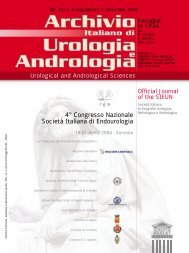7° Congresso Nazionale
7° Congresso Nazionale
7° Congresso Nazionale
Create successful ePaper yourself
Turn your PDF publications into a flip-book with our unique Google optimized e-Paper software.
46<br />
<strong>7°</strong> <strong>Congresso</strong> <strong>Nazionale</strong> Associazione Italiana di Endourologia<br />
Table 3.<br />
Comparison of results in blood loss in various nephrostomy tract techniques.<br />
Technique Patients Ext. blood loss p (Miniperc vs all other)<br />
Miniperc 63 (actual series) 0,65 ± 1,05 g/dL<br />
Alken dilators 59 (previous series) 2,08 ± 1,43 g/dL < 0,001<br />
One- Shot 36 (previous series) 1,64 ± 0,95 g/dL < 0,05<br />
Pneumatic dilation 15 (previous series) 1,90 ± 1,12 g/dL < 0,02<br />
for patients with Alken dilators access; 4,75 + 1,99 days<br />
(range 2-13 days) for patients with One-Shot access;<br />
4,46 + 1,06 days (range 3-7 days) for patients with pneumatic<br />
dilation access; the data not reaches statistical significance,<br />
but the mean hospital stay after miniperc procedures<br />
seems shorter than after standard procedures.<br />
CONCLUSIONS<br />
Considering the literature that shows experiences mainly<br />
in paediatric surgery with different nephrostomic<br />
approach (reported range 11-24 Fr) it is opportune to<br />
put a limit to the mini percutaneous procedure. We agree<br />
to identifying “MINI perc” technique only to nephrostomic<br />
approach ≤ 14 Fr and have manufactured the set<br />
in accordance.<br />
Superior approach cannot be intended Mini procedures<br />
but just “MIDI”. Please consider that the main manufactures<br />
of endourologic equipment are moving in accordance<br />
with this line. In case of failure or operation difficulties<br />
the approach can be easily converted and<br />
increased to allow standard procedures.<br />
The limits of this technique are: major operation times<br />
and consequently major costs; more difficulties in vision<br />
and operability. The advantages are: less trauma, reduction<br />
of bleeding, possibility of tubeless procedures and<br />
shorter recovery times.<br />
Supine position is certainly a step forward in terms of<br />
reducing operative times and percentage of clearance of<br />
the fragments. In fact the LASER lithotripsy and the<br />
decubitus allow litholopaxy of the fragments thanks to<br />
the gravity and the retrograde continuous irrigation.<br />
Moreover the possibility of using flexible ureteroscopes<br />
allows a better access to all the kidney calices and consequently<br />
an easier extraction of fragments.<br />
We estimate, with the right indications, that the Miniperc<br />
should be more and more adopted by modern endourol-<br />
Archivio Italiano di Urologia e Andrologia 2007, 79, 3, Supplemento 1<br />
ogists. The progress mainly in optics and the miniaturization<br />
of instruments will make the procedure more<br />
useful and effective.<br />
REFERENCES<br />
1. Traxer O, Smith Thomas G.III, Pearle M S, Corvin T S,<br />
Saboorian H, Careddu JA: Renal parenchymal injury after standard<br />
and mini percutaneous nephrostolithotomy. J Urol 2001;<br />
165(5):1693-1695.<br />
2. Jackman SV, Docimo SG, Careddu JA et al: The “miniperc” tecnique:<br />
a less invasive alternative to percutaneous nephrolithotomy.<br />
World J Urol 1998; 16:371-374.<br />
3. Helal M, Black T, Lockhart J, et al: The Hickman peelaway<br />
sheath:alternative for pediatric percutaneous nephrolithotomy. J<br />
Endourol 1997; 11:171-172<br />
4. Feng MI, Tamaddon K, Mikhail A, Kaptein JS, Bellman GC:<br />
Prospective randomized study of various techniques of percutaneous<br />
nephrolithotomy. Urology 2001; 58(3):345-350.<br />
5. Chan D-Y; Jarrett TW: Mini-Percutaneous Nephrolithotomy.<br />
J.Endourol. 2000; 14(3):269-273.<br />
6. Bhargava A.,Gupta V.K: Role of “Mini-perc” in the management<br />
of urolithiasis.(abstract FP4-4) J Endourol 2003 (suppl) A36.<br />
7. Monga M, Oglevie S : Mini-Percutaneous nephrolithotomy:<br />
extended experience and follow-up.(abstract FP4-12) J Endourol<br />
2003 (suppl) A38.<br />
8. Desai M, Ridhorkar V, Patel S et al.: Pediatric percutnaeous<br />
nephrolithotomy : assessing impact of technical innovations on safety<br />
and efficacy. J Enrodurol 1999; 13(5):359-64.<br />
9. Zattoni F, Passerini-Glazel G, Tasca A.: Pediatric nephroscope for<br />
percutaneous stone removal. Urology 1989; 33:404-406.<br />
10. Frattini A, Barbieri A, Salsi P, Sebastio N, Ferretti S,<br />
Bergamaschi E, Cortellini P. One shot: A novel method to dilate the<br />
nephrostomy access for percutaneous lithotripsy. J Endourol 2001;<br />
15 (9):919-923.<br />
Correspondence: Stefania Ferretti M.D., Urology Unit, Azienda Ospedaliero-Universitaria of Parma, via Gramsci, 14 – 43100 Parma, Italy<br />
E-mail: ferretti@ao.pr.it



